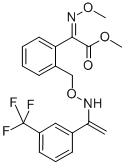
Trifloxystrobin
Bezeichnung:Trifloxystrobin
CAS-Nr141517-21-7
Englisch Name:Trifloxystrobin
CBNumberCB3757745
SummenformelC20H19F3N2O4
Molgewicht408.37
MOL-Datei141517-21-7.mol
Trifloxystrobin physikalisch-chemischer Eigenschaften
| Schmelzpunkt | 72.9° |
| Siedepunkt | bp~312° |
| Dichte | 1.21±0.1 g/cm3(Predicted) |
| Flammpunkt | >70 °C |
| storage temp. | Sealed in dry,2-8°C |
| Löslichkeit | Chloroform: Slightly Soluble; Methanol: Slightly Soluble |
| Aggregatzustand | Solid |
| Farbe | White to off-white |
| Stabilität | Hygroscopic, Moisture Sensitive |
| InChI | InChI=1S/C20H19F3N2O4/c1-13(14-8-6-9-16(11-14)20(21,22)23)24-29-12-15-7-4-5-10-17(15)18(25-28-3)19(26)27-2/h4-11,24H,1,12H2,2-3H3/b25-18- |
| InChIKey | MGNJFZURPQVGJE-BWAHOGKJSA-N |
| SMILES | C1(=CC=CC=C1CONC(=C)C1C=CC=C(C(F)(F)F)C=1)/C(=N/OC)/C(=O)OC |
| LogP | 5.112 (est) |
| EPA chemische Informationen | Trifloxystrobin (141517-21-7) |
| Kennzeichnung gefährlicher | Xi,N |
| R-Sätze: | 43-50/53 |
| S-Sätze: | 24-37-46-60-61 |
| RIDADR | UN3077 9/PG 3 |
| WGK Germany | 2 |
| Giftige Stoffe Daten | 141517-21-7(Hazardous Substances Data) |
| Toxizität | LD50 in rats (mg/kg): >5000 orally; >2000 dermally; LC50 by inhalation in rats (mg/m3): >4646; LC50 in bobwhite quail (mg/kg): >2000; LC50 in rainbow trout (mg/l): 0.015 (Margot) |


